Case Study Analysis: Resolving Conflicting Values in Organizations
VerifiedAdded on 2023/06/03
|9
|1639
|113
Case Study
AI Summary
This assignment presents a case analysis of two distinct scenarios: one involving an Indian IT company, Parivar, grappling with a strong but potentially claustrophobic organizational culture and high employee turnover, and the other focusing on Cheryl Hailstorm, a new CEO facing resistance to her growth strategies due to conflicting values and a lack of employee buy-in. The analysis identifies conflicting values within each case, such as the clash between a paternalistic culture and employee expectations in Parivar, and the tension between an authoritarian leadership style and established organizational pace in Cheryl's situation. Recommendations are provided for both Sudhir Gupta of Parivar and Cheryl Hailstorm, emphasizing the need for cultural adaptation, employee engagement, and improved communication. Furthermore, the analysis highlights the importance of VUCA-world management competencies, such as conflict resolution, employee engagement, and change management, for 21st-century leaders. The document concludes by suggesting a flatter organizational structure for Parivar to foster collaboration and improve employee retention.
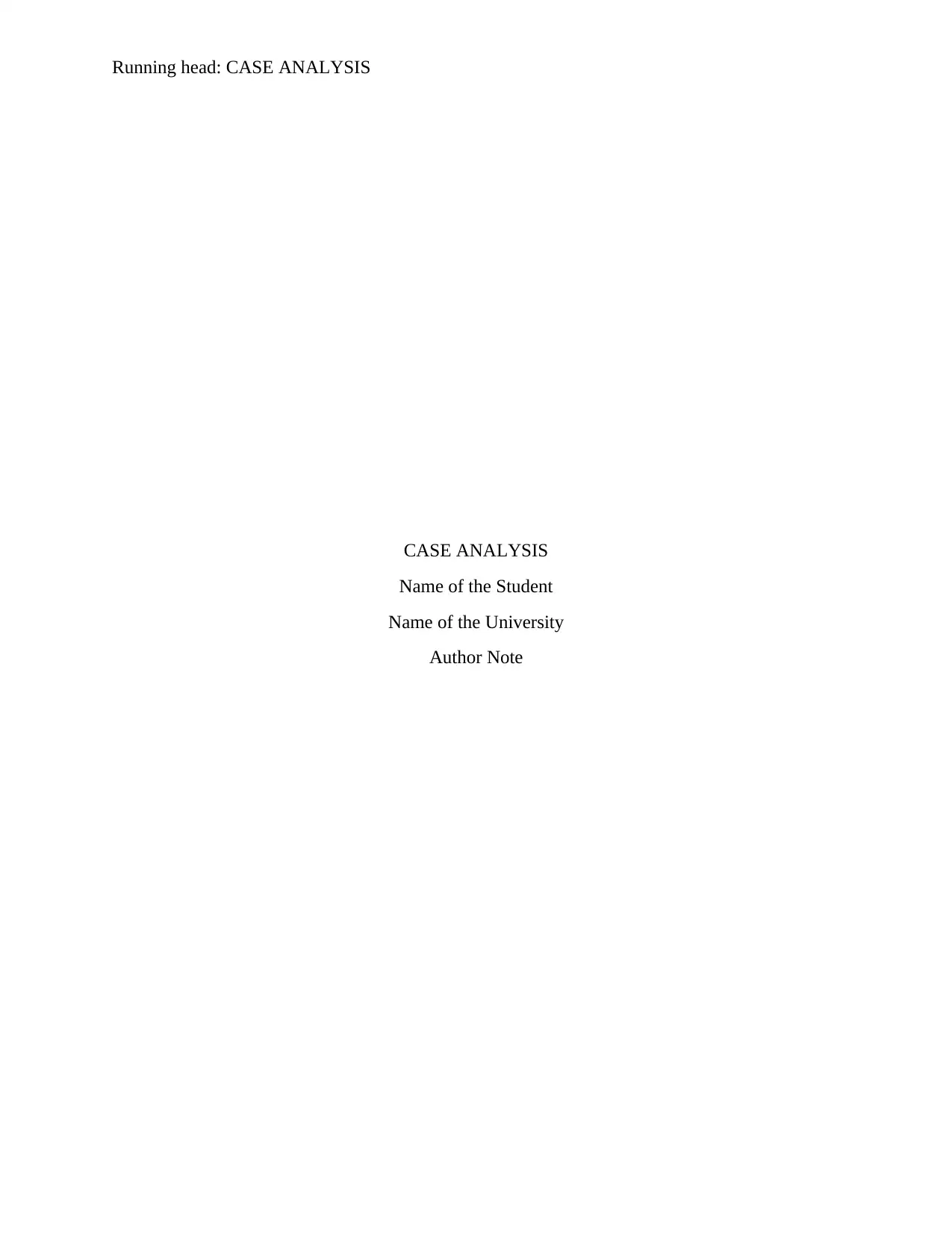
Running head: CASE ANALYSIS
CASE ANALYSIS
Name of the Student
Name of the University
Author Note
CASE ANALYSIS
Name of the Student
Name of the University
Author Note
Paraphrase This Document
Need a fresh take? Get an instant paraphrase of this document with our AI Paraphraser
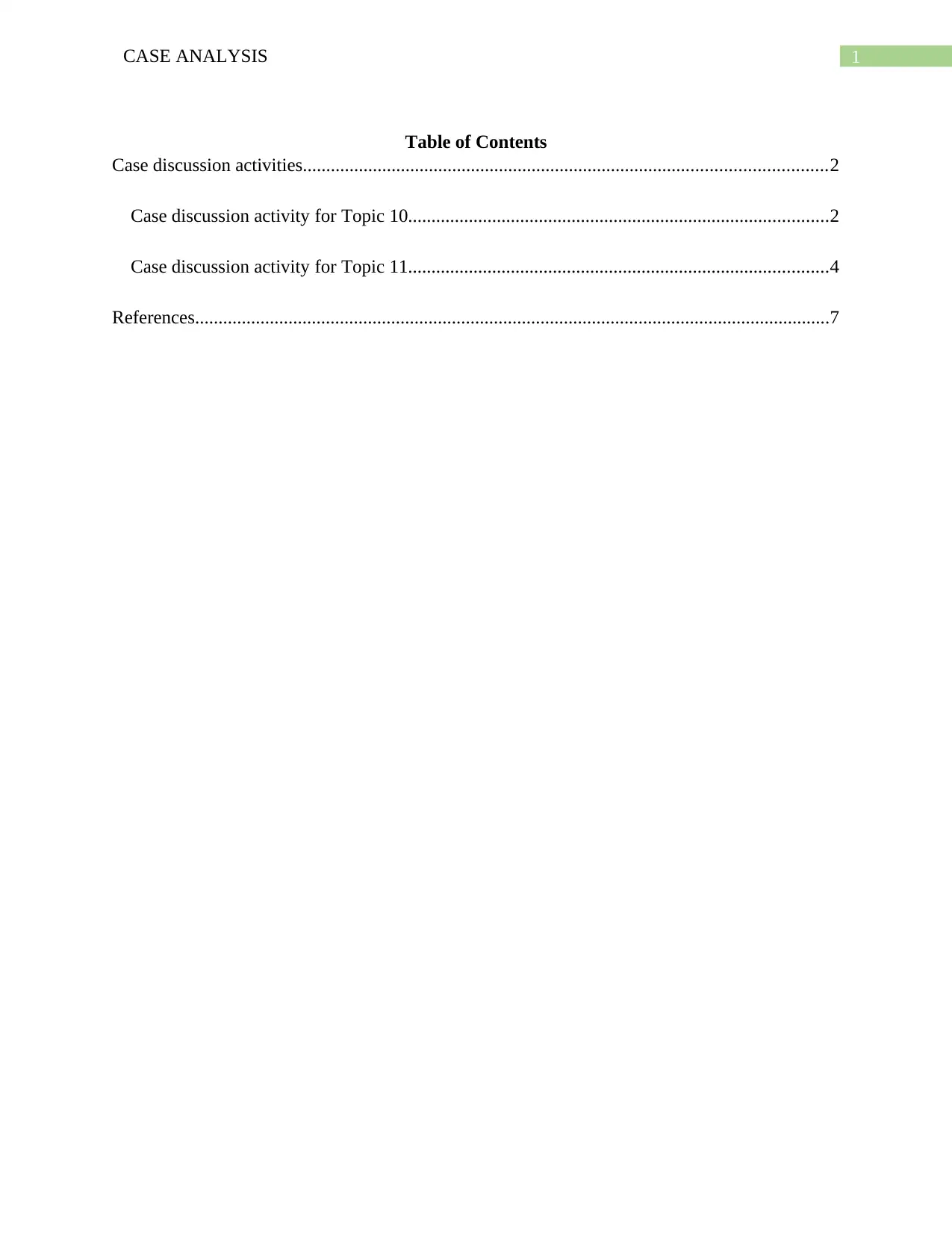
1CASE ANALYSIS
Table of Contents
Case discussion activities................................................................................................................2
Case discussion activity for Topic 10..........................................................................................2
Case discussion activity for Topic 11..........................................................................................4
References........................................................................................................................................7
Table of Contents
Case discussion activities................................................................................................................2
Case discussion activity for Topic 10..........................................................................................2
Case discussion activity for Topic 11..........................................................................................4
References........................................................................................................................................7
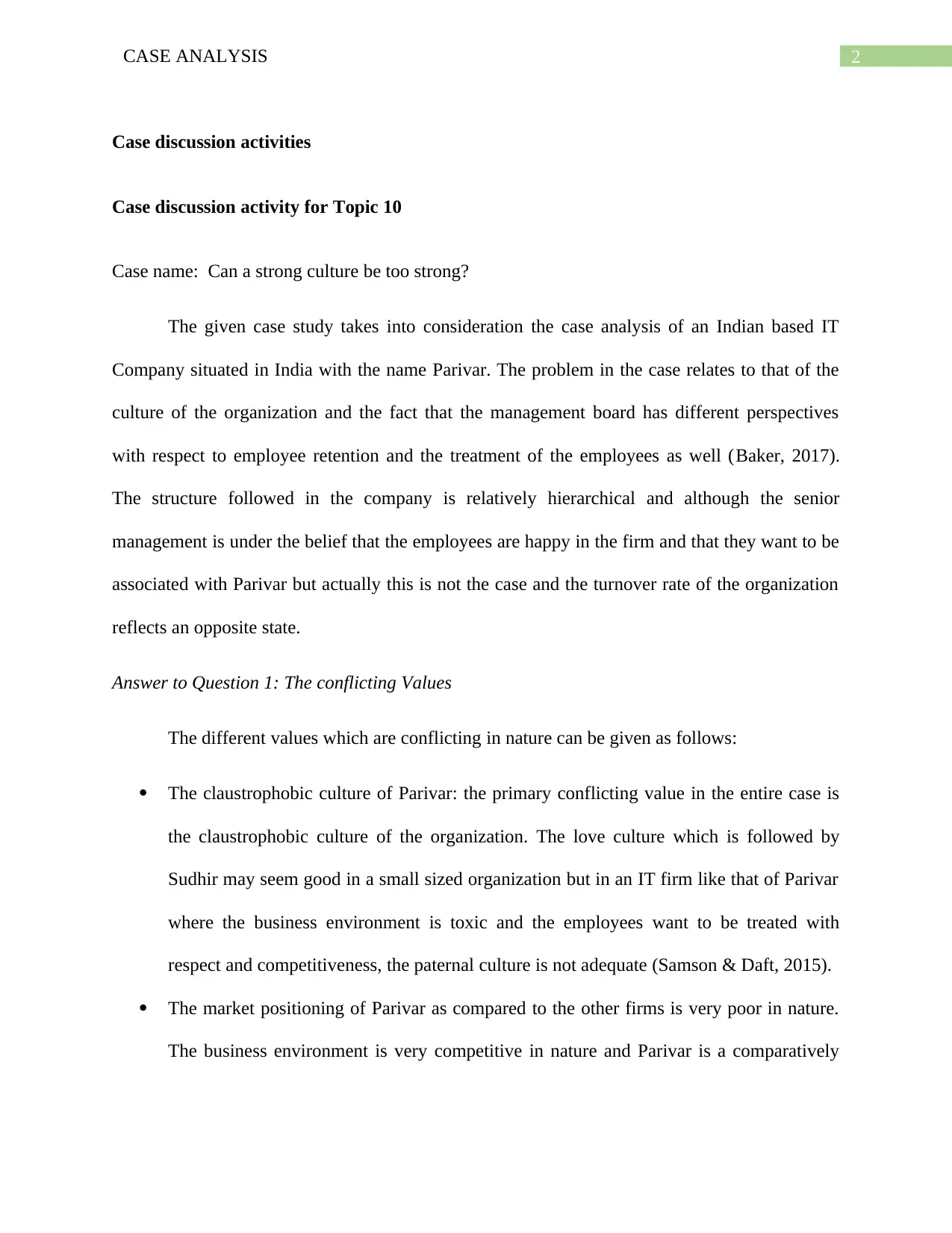
2CASE ANALYSIS
Case discussion activities
Case discussion activity for Topic 10
Case name: Can a strong culture be too strong?
The given case study takes into consideration the case analysis of an Indian based IT
Company situated in India with the name Parivar. The problem in the case relates to that of the
culture of the organization and the fact that the management board has different perspectives
with respect to employee retention and the treatment of the employees as well (Baker, 2017).
The structure followed in the company is relatively hierarchical and although the senior
management is under the belief that the employees are happy in the firm and that they want to be
associated with Parivar but actually this is not the case and the turnover rate of the organization
reflects an opposite state.
Answer to Question 1: The conflicting Values
The different values which are conflicting in nature can be given as follows:
The claustrophobic culture of Parivar: the primary conflicting value in the entire case is
the claustrophobic culture of the organization. The love culture which is followed by
Sudhir may seem good in a small sized organization but in an IT firm like that of Parivar
where the business environment is toxic and the employees want to be treated with
respect and competitiveness, the paternal culture is not adequate (Samson & Daft, 2015).
The market positioning of Parivar as compared to the other firms is very poor in nature.
The business environment is very competitive in nature and Parivar is a comparatively
Case discussion activities
Case discussion activity for Topic 10
Case name: Can a strong culture be too strong?
The given case study takes into consideration the case analysis of an Indian based IT
Company situated in India with the name Parivar. The problem in the case relates to that of the
culture of the organization and the fact that the management board has different perspectives
with respect to employee retention and the treatment of the employees as well (Baker, 2017).
The structure followed in the company is relatively hierarchical and although the senior
management is under the belief that the employees are happy in the firm and that they want to be
associated with Parivar but actually this is not the case and the turnover rate of the organization
reflects an opposite state.
Answer to Question 1: The conflicting Values
The different values which are conflicting in nature can be given as follows:
The claustrophobic culture of Parivar: the primary conflicting value in the entire case is
the claustrophobic culture of the organization. The love culture which is followed by
Sudhir may seem good in a small sized organization but in an IT firm like that of Parivar
where the business environment is toxic and the employees want to be treated with
respect and competitiveness, the paternal culture is not adequate (Samson & Daft, 2015).
The market positioning of Parivar as compared to the other firms is very poor in nature.
The business environment is very competitive in nature and Parivar is a comparatively
⊘ This is a preview!⊘
Do you want full access?
Subscribe today to unlock all pages.

Trusted by 1+ million students worldwide
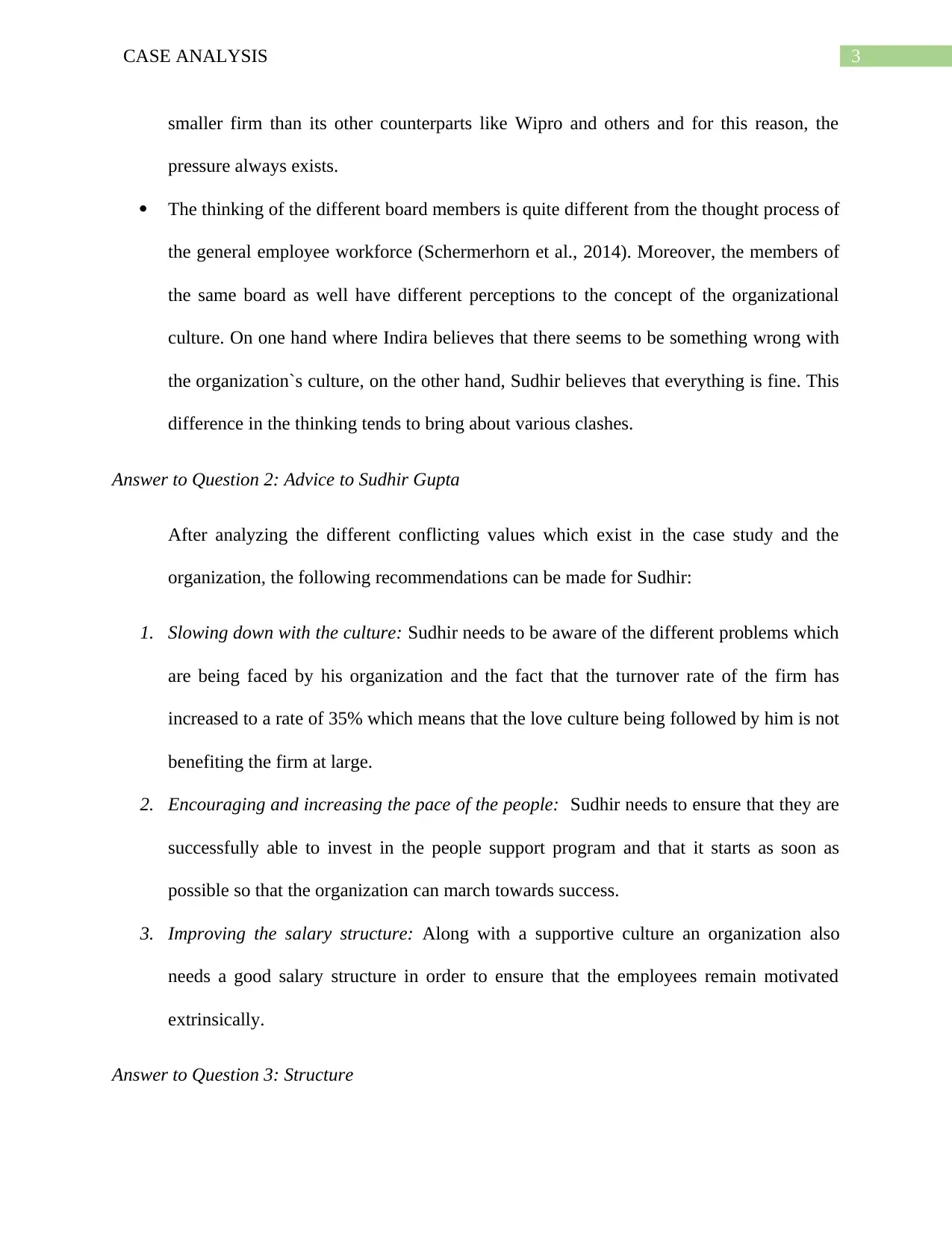
3CASE ANALYSIS
smaller firm than its other counterparts like Wipro and others and for this reason, the
pressure always exists.
The thinking of the different board members is quite different from the thought process of
the general employee workforce (Schermerhorn et al., 2014). Moreover, the members of
the same board as well have different perceptions to the concept of the organizational
culture. On one hand where Indira believes that there seems to be something wrong with
the organization`s culture, on the other hand, Sudhir believes that everything is fine. This
difference in the thinking tends to bring about various clashes.
Answer to Question 2: Advice to Sudhir Gupta
After analyzing the different conflicting values which exist in the case study and the
organization, the following recommendations can be made for Sudhir:
1. Slowing down with the culture: Sudhir needs to be aware of the different problems which
are being faced by his organization and the fact that the turnover rate of the firm has
increased to a rate of 35% which means that the love culture being followed by him is not
benefiting the firm at large.
2. Encouraging and increasing the pace of the people: Sudhir needs to ensure that they are
successfully able to invest in the people support program and that it starts as soon as
possible so that the organization can march towards success.
3. Improving the salary structure: Along with a supportive culture an organization also
needs a good salary structure in order to ensure that the employees remain motivated
extrinsically.
Answer to Question 3: Structure
smaller firm than its other counterparts like Wipro and others and for this reason, the
pressure always exists.
The thinking of the different board members is quite different from the thought process of
the general employee workforce (Schermerhorn et al., 2014). Moreover, the members of
the same board as well have different perceptions to the concept of the organizational
culture. On one hand where Indira believes that there seems to be something wrong with
the organization`s culture, on the other hand, Sudhir believes that everything is fine. This
difference in the thinking tends to bring about various clashes.
Answer to Question 2: Advice to Sudhir Gupta
After analyzing the different conflicting values which exist in the case study and the
organization, the following recommendations can be made for Sudhir:
1. Slowing down with the culture: Sudhir needs to be aware of the different problems which
are being faced by his organization and the fact that the turnover rate of the firm has
increased to a rate of 35% which means that the love culture being followed by him is not
benefiting the firm at large.
2. Encouraging and increasing the pace of the people: Sudhir needs to ensure that they are
successfully able to invest in the people support program and that it starts as soon as
possible so that the organization can march towards success.
3. Improving the salary structure: Along with a supportive culture an organization also
needs a good salary structure in order to ensure that the employees remain motivated
extrinsically.
Answer to Question 3: Structure
Paraphrase This Document
Need a fresh take? Get an instant paraphrase of this document with our AI Paraphraser
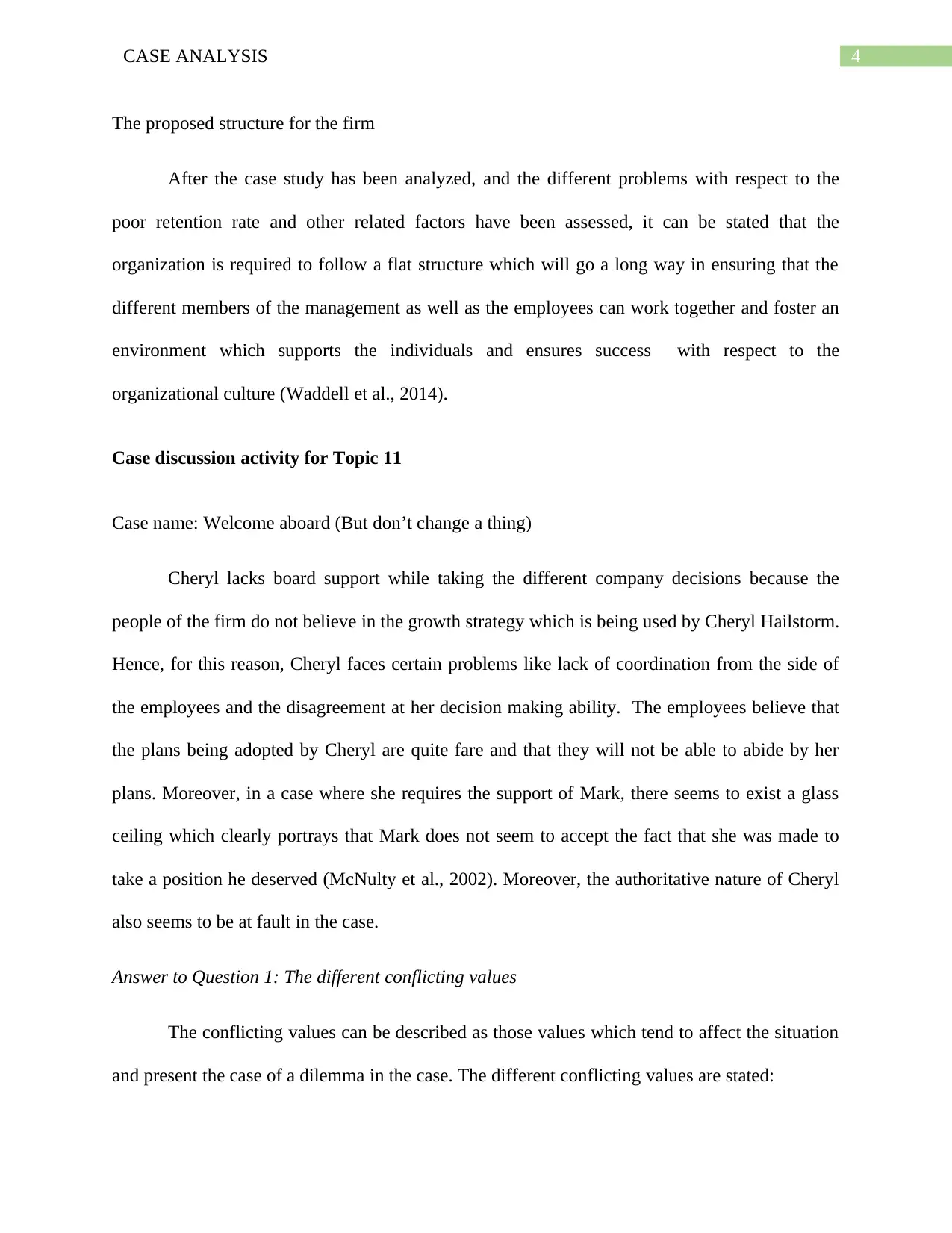
4CASE ANALYSIS
The proposed structure for the firm
After the case study has been analyzed, and the different problems with respect to the
poor retention rate and other related factors have been assessed, it can be stated that the
organization is required to follow a flat structure which will go a long way in ensuring that the
different members of the management as well as the employees can work together and foster an
environment which supports the individuals and ensures success with respect to the
organizational culture (Waddell et al., 2014).
Case discussion activity for Topic 11
Case name: Welcome aboard (But don’t change a thing)
Cheryl lacks board support while taking the different company decisions because the
people of the firm do not believe in the growth strategy which is being used by Cheryl Hailstorm.
Hence, for this reason, Cheryl faces certain problems like lack of coordination from the side of
the employees and the disagreement at her decision making ability. The employees believe that
the plans being adopted by Cheryl are quite fare and that they will not be able to abide by her
plans. Moreover, in a case where she requires the support of Mark, there seems to exist a glass
ceiling which clearly portrays that Mark does not seem to accept the fact that she was made to
take a position he deserved (McNulty et al., 2002). Moreover, the authoritative nature of Cheryl
also seems to be at fault in the case.
Answer to Question 1: The different conflicting values
The conflicting values can be described as those values which tend to affect the situation
and present the case of a dilemma in the case. The different conflicting values are stated:
The proposed structure for the firm
After the case study has been analyzed, and the different problems with respect to the
poor retention rate and other related factors have been assessed, it can be stated that the
organization is required to follow a flat structure which will go a long way in ensuring that the
different members of the management as well as the employees can work together and foster an
environment which supports the individuals and ensures success with respect to the
organizational culture (Waddell et al., 2014).
Case discussion activity for Topic 11
Case name: Welcome aboard (But don’t change a thing)
Cheryl lacks board support while taking the different company decisions because the
people of the firm do not believe in the growth strategy which is being used by Cheryl Hailstorm.
Hence, for this reason, Cheryl faces certain problems like lack of coordination from the side of
the employees and the disagreement at her decision making ability. The employees believe that
the plans being adopted by Cheryl are quite fare and that they will not be able to abide by her
plans. Moreover, in a case where she requires the support of Mark, there seems to exist a glass
ceiling which clearly portrays that Mark does not seem to accept the fact that she was made to
take a position he deserved (McNulty et al., 2002). Moreover, the authoritative nature of Cheryl
also seems to be at fault in the case.
Answer to Question 1: The different conflicting values
The conflicting values can be described as those values which tend to affect the situation
and present the case of a dilemma in the case. The different conflicting values are stated:
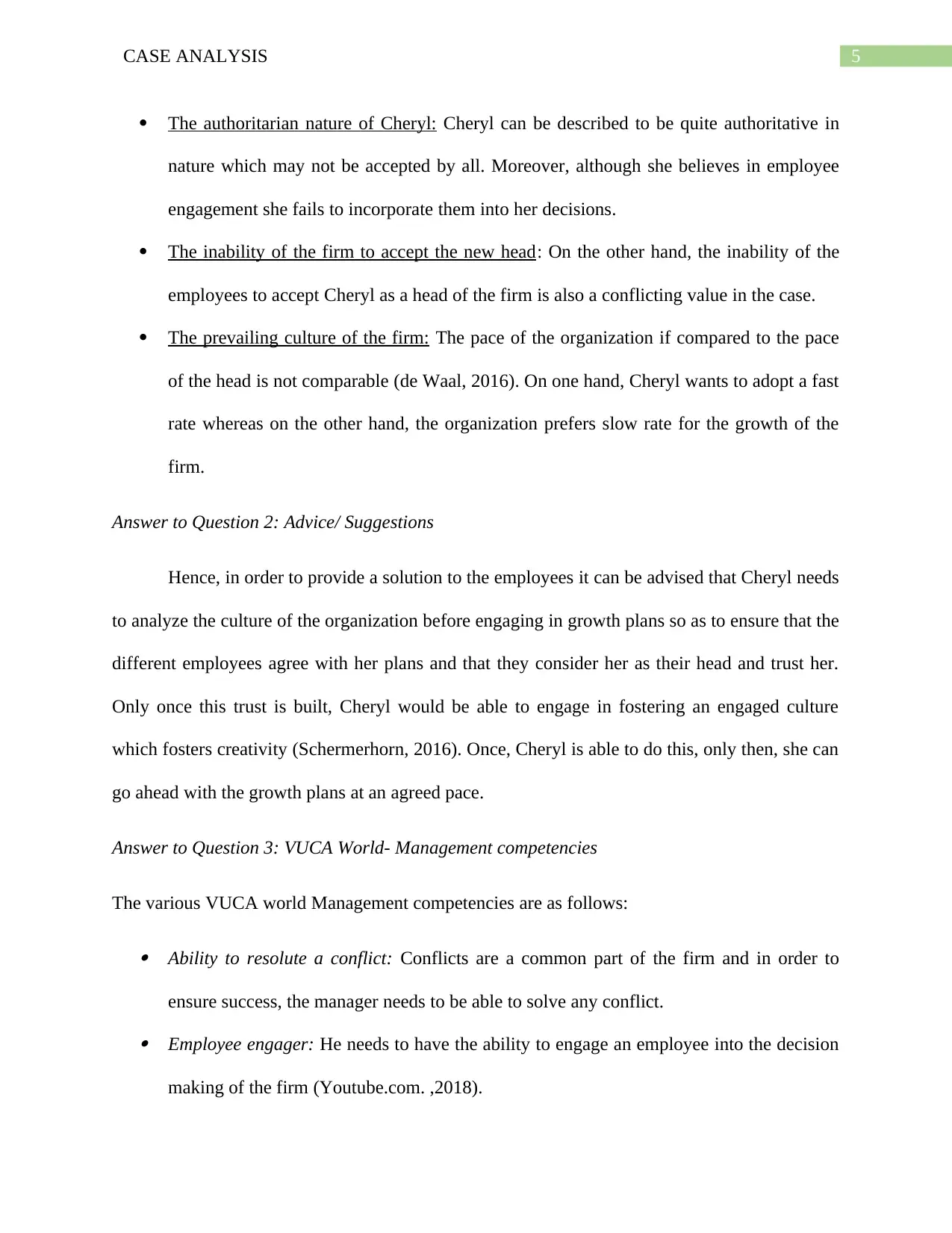
5CASE ANALYSIS
The authoritarian nature of Cheryl: Cheryl can be described to be quite authoritative in
nature which may not be accepted by all. Moreover, although she believes in employee
engagement she fails to incorporate them into her decisions.
The inability of the firm to accept the new head: On the other hand, the inability of the
employees to accept Cheryl as a head of the firm is also a conflicting value in the case.
The prevailing culture of the firm: The pace of the organization if compared to the pace
of the head is not comparable (de Waal, 2016). On one hand, Cheryl wants to adopt a fast
rate whereas on the other hand, the organization prefers slow rate for the growth of the
firm.
Answer to Question 2: Advice/ Suggestions
Hence, in order to provide a solution to the employees it can be advised that Cheryl needs
to analyze the culture of the organization before engaging in growth plans so as to ensure that the
different employees agree with her plans and that they consider her as their head and trust her.
Only once this trust is built, Cheryl would be able to engage in fostering an engaged culture
which fosters creativity (Schermerhorn, 2016). Once, Cheryl is able to do this, only then, she can
go ahead with the growth plans at an agreed pace.
Answer to Question 3: VUCA World- Management competencies
The various VUCA world Management competencies are as follows:
Ability to resolute a conflict: Conflicts are a common part of the firm and in order to
ensure success, the manager needs to be able to solve any conflict. Employee engager: He needs to have the ability to engage an employee into the decision
making of the firm (Youtube.com. ,2018).
The authoritarian nature of Cheryl: Cheryl can be described to be quite authoritative in
nature which may not be accepted by all. Moreover, although she believes in employee
engagement she fails to incorporate them into her decisions.
The inability of the firm to accept the new head: On the other hand, the inability of the
employees to accept Cheryl as a head of the firm is also a conflicting value in the case.
The prevailing culture of the firm: The pace of the organization if compared to the pace
of the head is not comparable (de Waal, 2016). On one hand, Cheryl wants to adopt a fast
rate whereas on the other hand, the organization prefers slow rate for the growth of the
firm.
Answer to Question 2: Advice/ Suggestions
Hence, in order to provide a solution to the employees it can be advised that Cheryl needs
to analyze the culture of the organization before engaging in growth plans so as to ensure that the
different employees agree with her plans and that they consider her as their head and trust her.
Only once this trust is built, Cheryl would be able to engage in fostering an engaged culture
which fosters creativity (Schermerhorn, 2016). Once, Cheryl is able to do this, only then, she can
go ahead with the growth plans at an agreed pace.
Answer to Question 3: VUCA World- Management competencies
The various VUCA world Management competencies are as follows:
Ability to resolute a conflict: Conflicts are a common part of the firm and in order to
ensure success, the manager needs to be able to solve any conflict. Employee engager: He needs to have the ability to engage an employee into the decision
making of the firm (Youtube.com. ,2018).
⊘ This is a preview!⊘
Do you want full access?
Subscribe today to unlock all pages.

Trusted by 1+ million students worldwide
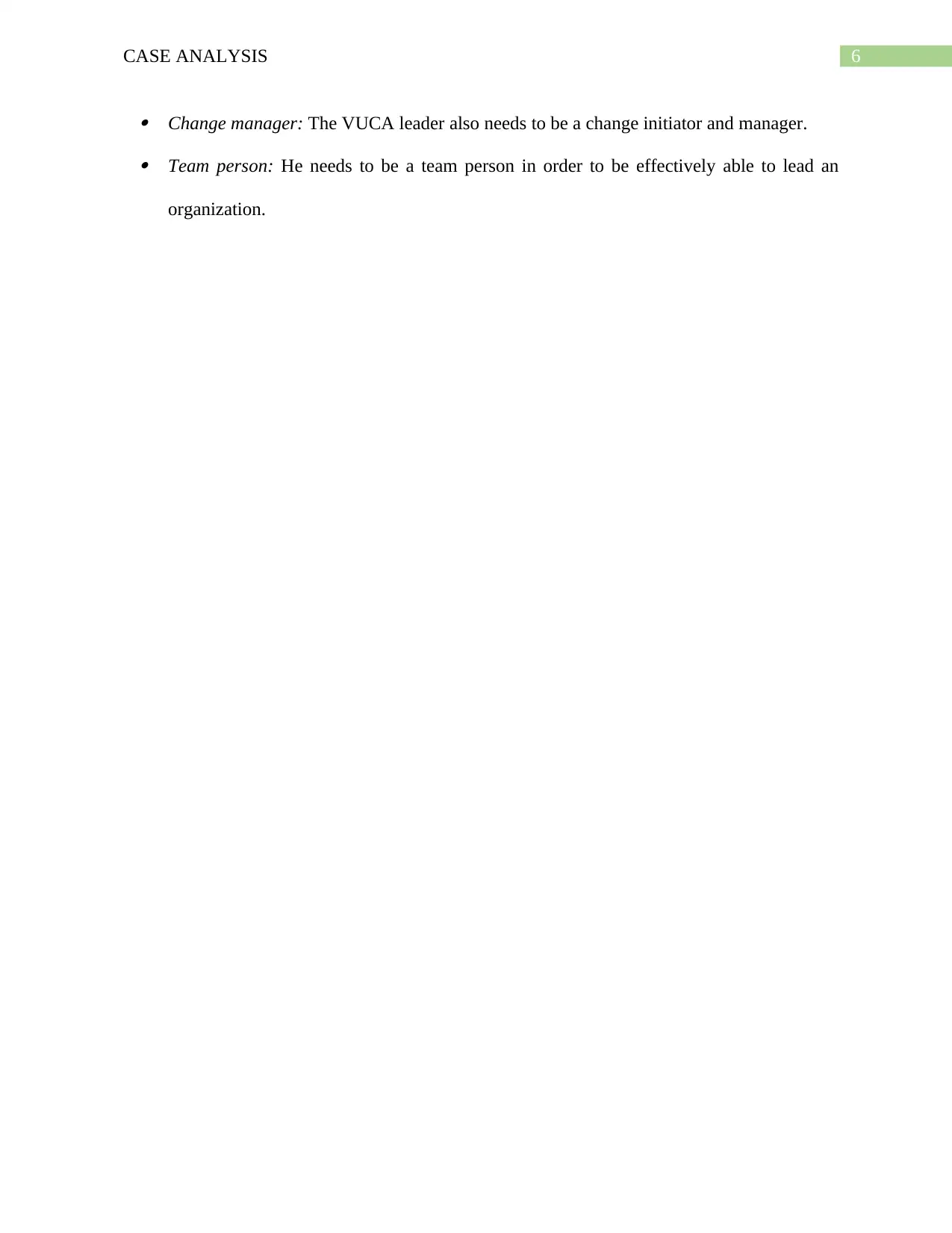
6CASE ANALYSIS
Change manager: The VUCA leader also needs to be a change initiator and manager. Team person: He needs to be a team person in order to be effectively able to lead an
organization.
Change manager: The VUCA leader also needs to be a change initiator and manager. Team person: He needs to be a team person in order to be effectively able to lead an
organization.
Paraphrase This Document
Need a fresh take? Get an instant paraphrase of this document with our AI Paraphraser
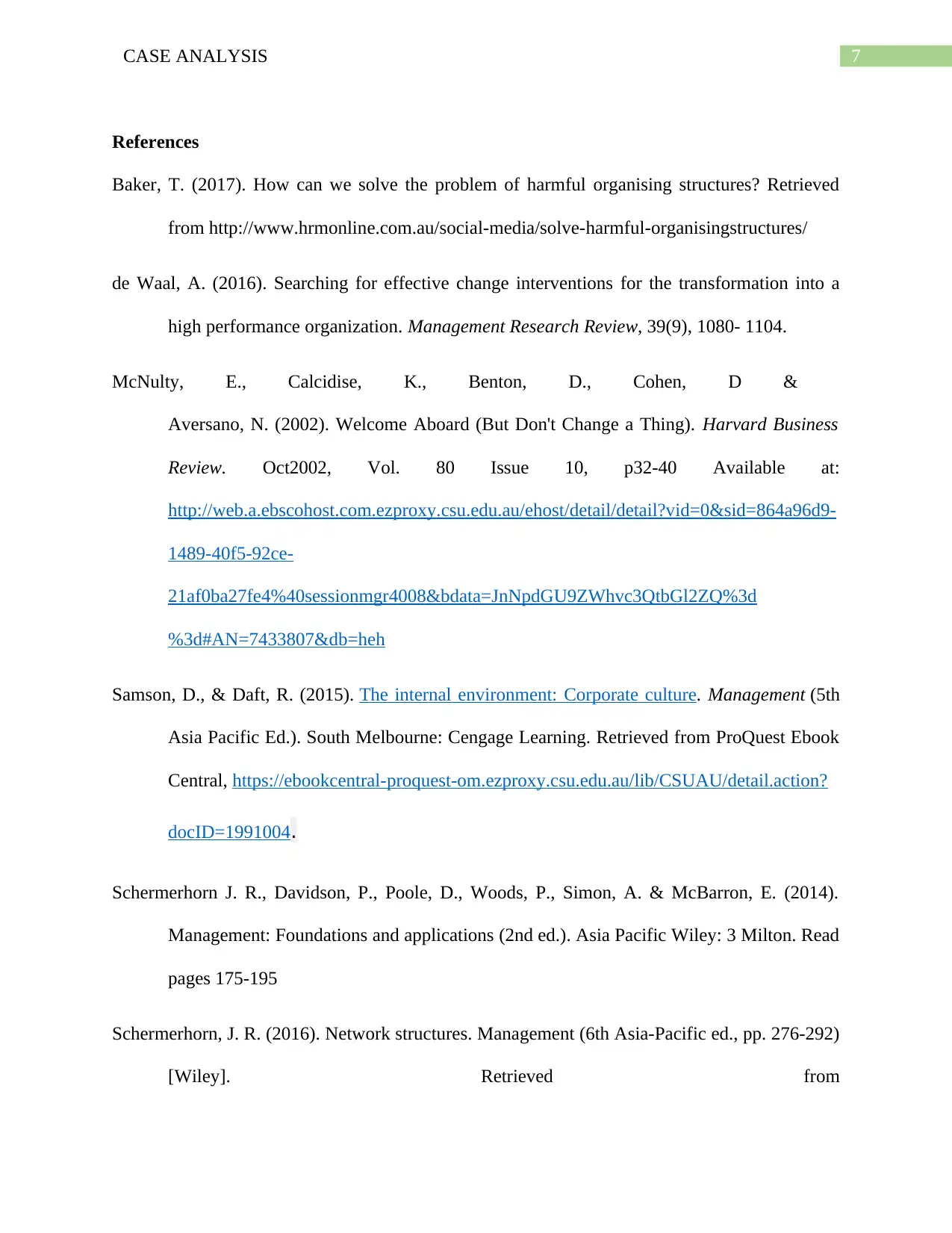
7CASE ANALYSIS
References
Baker, T. (2017). How can we solve the problem of harmful organising structures? Retrieved
from http://www.hrmonline.com.au/social-media/solve-harmful-organisingstructures/
de Waal, A. (2016). Searching for effective change interventions for the transformation into a
high performance organization. Management Research Review, 39(9), 1080- 1104.
McNulty, E., Calcidise, K., Benton, D., Cohen, D &
Aversano, N. (2002). Welcome Aboard (But Don't Change a Thing). Harvard Business
Review. Oct2002, Vol. 80 Issue 10, p32-40 Available at:
http://web.a.ebscohost.com.ezproxy.csu.edu.au/ehost/detail/detail?vid=0&sid=864a96d9-
1489-40f5-92ce-
21af0ba27fe4%40sessionmgr4008&bdata=JnNpdGU9ZWhvc3QtbGl2ZQ%3d
%3d#AN=7433807&db=heh
Samson, D., & Daft, R. (2015). The internal environment: Corporate culture. Management (5th
Asia Pacific Ed.). South Melbourne: Cengage Learning. Retrieved from ProQuest Ebook
Central, https://ebookcentral-proquest-om.ezproxy.csu.edu.au/lib/CSUAU/detail.action?
docID=1991004.
Schermerhorn J. R., Davidson, P., Poole, D., Woods, P., Simon, A. & McBarron, E. (2014).
Management: Foundations and applications (2nd ed.). Asia Pacific Wiley: 3 Milton. Read
pages 175-195
Schermerhorn, J. R. (2016). Network structures. Management (6th Asia-Pacific ed., pp. 276-292)
[Wiley]. Retrieved from
References
Baker, T. (2017). How can we solve the problem of harmful organising structures? Retrieved
from http://www.hrmonline.com.au/social-media/solve-harmful-organisingstructures/
de Waal, A. (2016). Searching for effective change interventions for the transformation into a
high performance organization. Management Research Review, 39(9), 1080- 1104.
McNulty, E., Calcidise, K., Benton, D., Cohen, D &
Aversano, N. (2002). Welcome Aboard (But Don't Change a Thing). Harvard Business
Review. Oct2002, Vol. 80 Issue 10, p32-40 Available at:
http://web.a.ebscohost.com.ezproxy.csu.edu.au/ehost/detail/detail?vid=0&sid=864a96d9-
1489-40f5-92ce-
21af0ba27fe4%40sessionmgr4008&bdata=JnNpdGU9ZWhvc3QtbGl2ZQ%3d
%3d#AN=7433807&db=heh
Samson, D., & Daft, R. (2015). The internal environment: Corporate culture. Management (5th
Asia Pacific Ed.). South Melbourne: Cengage Learning. Retrieved from ProQuest Ebook
Central, https://ebookcentral-proquest-om.ezproxy.csu.edu.au/lib/CSUAU/detail.action?
docID=1991004.
Schermerhorn J. R., Davidson, P., Poole, D., Woods, P., Simon, A. & McBarron, E. (2014).
Management: Foundations and applications (2nd ed.). Asia Pacific Wiley: 3 Milton. Read
pages 175-195
Schermerhorn, J. R. (2016). Network structures. Management (6th Asia-Pacific ed., pp. 276-292)
[Wiley]. Retrieved from
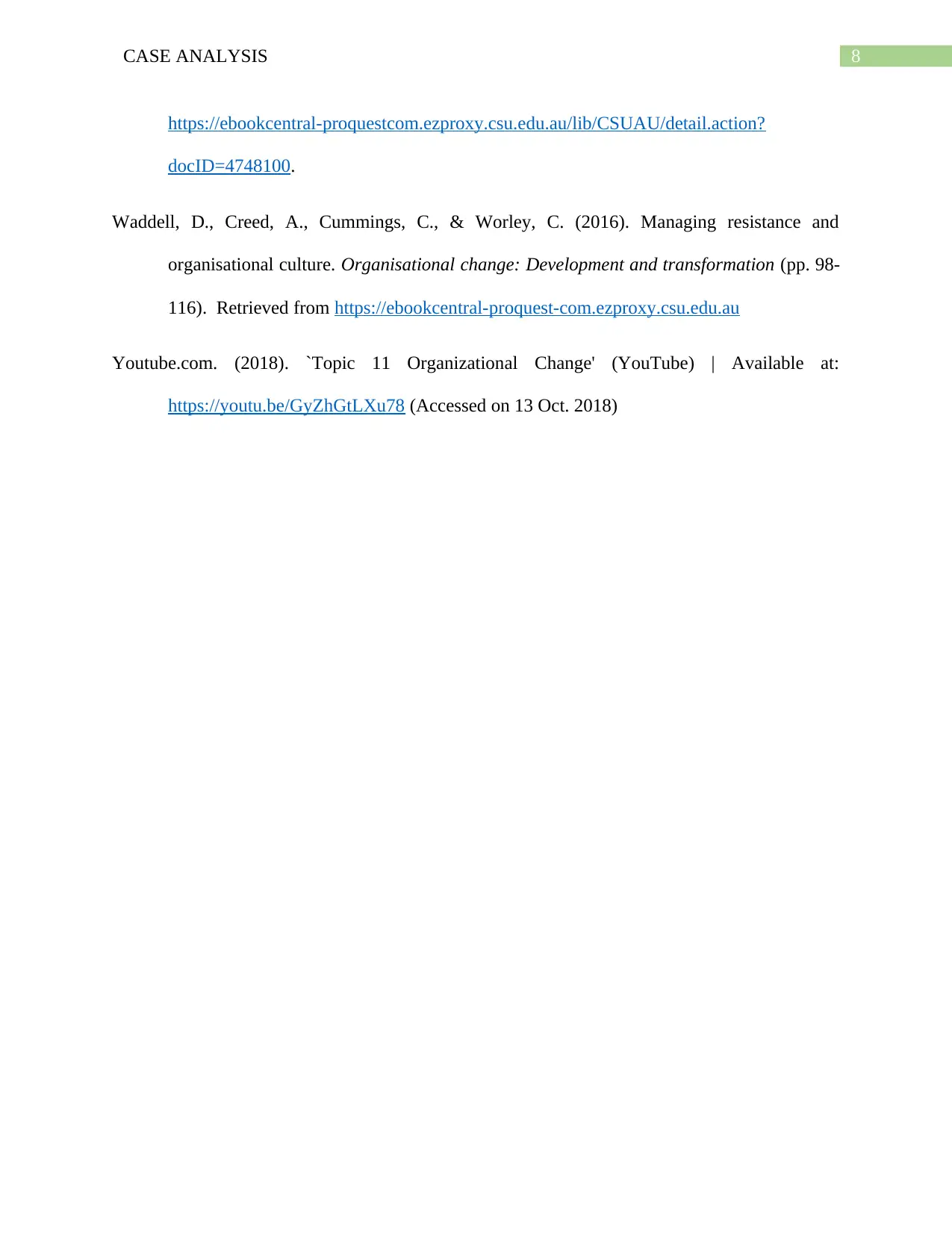
8CASE ANALYSIS
https://ebookcentral-proquestcom.ezproxy.csu.edu.au/lib/CSUAU/detail.action?
docID=4748100.
Waddell, D., Creed, A., Cummings, C., & Worley, C. (2016). Managing resistance and
organisational culture. Organisational change: Development and transformation (pp. 98-
116). Retrieved from https://ebookcentral-proquest-com.ezproxy.csu.edu.au
Youtube.com. (2018). `Topic 11 Organizational Change' (YouTube) | Available at:
https://youtu.be/GyZhGtLXu78 (Accessed on 13 Oct. 2018)
https://ebookcentral-proquestcom.ezproxy.csu.edu.au/lib/CSUAU/detail.action?
docID=4748100.
Waddell, D., Creed, A., Cummings, C., & Worley, C. (2016). Managing resistance and
organisational culture. Organisational change: Development and transformation (pp. 98-
116). Retrieved from https://ebookcentral-proquest-com.ezproxy.csu.edu.au
Youtube.com. (2018). `Topic 11 Organizational Change' (YouTube) | Available at:
https://youtu.be/GyZhGtLXu78 (Accessed on 13 Oct. 2018)
⊘ This is a preview!⊘
Do you want full access?
Subscribe today to unlock all pages.

Trusted by 1+ million students worldwide
1 out of 9
Related Documents
Your All-in-One AI-Powered Toolkit for Academic Success.
+13062052269
info@desklib.com
Available 24*7 on WhatsApp / Email
![[object Object]](/_next/static/media/star-bottom.7253800d.svg)
Unlock your academic potential
Copyright © 2020–2025 A2Z Services. All Rights Reserved. Developed and managed by ZUCOL.





